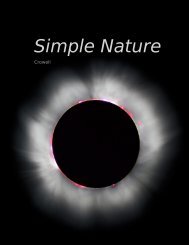The size of a radio antenna is closely related to ... - Light and Matter
The size of a radio antenna is closely related to ... - Light and Matter
The size of a radio antenna is closely related to ... - Light and Matter
Create successful ePaper yourself
Turn your PDF publications into a flip-book with our unique Google optimized e-Paper software.
6.2 Bounded Waves<br />
Speech <strong>is</strong> what separates humans most dec<strong>is</strong>ively from animals. No<br />
other species can master syntax, <strong>and</strong> even though chimpanzees can<br />
learn a vocabulary <strong>of</strong> h<strong>and</strong> signs, there <strong>is</strong> an unm<strong>is</strong>takable difference<br />
between a human infant <strong>and</strong> a baby chimp: starting from birth, the<br />
human experiments with the production <strong>of</strong> complex speech sounds.<br />
Since speech sounds are instinctive for us, we seldom think about<br />
them consciously. How do we control sound waves so skillfully?<br />
Mostly we do it by changing the shape <strong>of</strong> a connected set <strong>of</strong> hollow<br />
cavities in our chest, throat, <strong>and</strong> head. Somehow by moving the<br />
boundaries <strong>of</strong> th<strong>is</strong> space in <strong>and</strong> out, we can produce all the vowel<br />
sounds. Up until now, we have been studying only those properties<br />
<strong>of</strong> waves that can be unders<strong>to</strong>od as if they ex<strong>is</strong>ted in an infinite,<br />
open space with no boundaries. In th<strong>is</strong> chapter we address what<br />
happens when a wave <strong>is</strong> confined within a certain space, or when a<br />
wave pattern encounters the boundary between two different media,<br />
such as when a light wave moving through air encounters a glass<br />
windowpane.<br />
a / A cross-sectional view <strong>of</strong><br />
a human body, showing the vocal<br />
tract.<br />
b / Circular water waves are<br />
reflected from a boundary on the<br />
left. (PSSC Physics)<br />
6.2.1 Reflection, transm<strong>is</strong>sion, <strong>and</strong> absorption<br />
Reflection <strong>and</strong> transm<strong>is</strong>sion<br />
Sound waves can echo back from a cliff, <strong>and</strong> light waves are<br />
reflected from the surface <strong>of</strong> a pond. We use the word reflection,<br />
normally applied only <strong>to</strong> light waves in ordinary speech, <strong>to</strong> describe<br />
any such case <strong>of</strong> a wave rebounding from a barrier. Figure (a) shows<br />
a circular water wave being reflected from a straight wall. In th<strong>is</strong><br />
chapter, we will concentrate mainly on reflection <strong>of</strong> waves that move<br />
in one dimension, as in figure c/1.<br />
Wave reflection does not surpr<strong>is</strong>e us. After all, a material object<br />
such as a rubber ball would bounce back in the same way. But waves<br />
are not objects, <strong>and</strong> there are some surpr<strong>is</strong>es in s<strong>to</strong>re.<br />
First, only part <strong>of</strong> the wave <strong>is</strong> usually reflected. Looking out<br />
through a window, we see light waves that passed through it, but a<br />
person st<strong>and</strong>ing outside would also be able <strong>to</strong> see her reflection in<br />
the glass. A light wave that strikes the glass <strong>is</strong> partly reflected <strong>and</strong><br />
partly transmitted (passed) by the glass. <strong>The</strong> energy <strong>of</strong> the original<br />
wave <strong>is</strong> split between the two. Th<strong>is</strong> <strong>is</strong> different from the behavior <strong>of</strong><br />
the rubber ball, which must go one way or the other, not both.<br />
Second, consider what you see if you are swimming underwater<br />
<strong>and</strong> you look up at the surface. You see your own reflection. Th<strong>is</strong><br />
<strong>is</strong> utterly counterintuitive, since we would expect the light waves <strong>to</strong><br />
burst forth <strong>to</strong> freedom in the wide-open air. A material projectile<br />
shot up <strong>to</strong>ward the surface would never rebound from the water-air<br />
boundary!<br />
What <strong>is</strong> it about the difference between two media that causes<br />
360 Chapter 6 Waves














